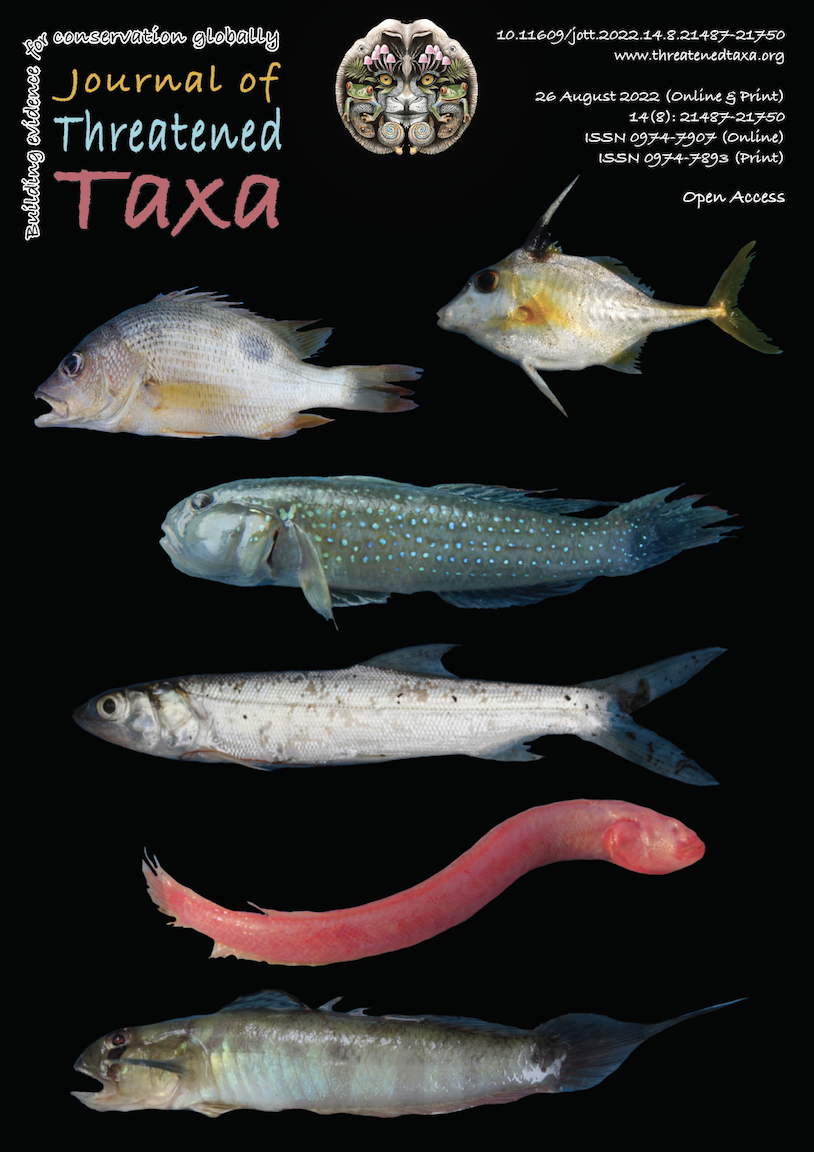Eremotermes neoparadoxalis Ahmad, 1955 (Isoptera: Termitidae: Amitermitinae) a new record from Haryana, India
Main Article Content
Abstract
We report a new record of Eremotermes neoparadoxalis from Haryana, India. Eremotermes Silvestri, 1911 is a highly dispersed genus epitomized by 10 species, six of which have been reported in India, including E. paradoxalis in Harayana. Taxonomic descriptions provided with illustrations of general morphology and measurements of body length, head length with and without mandibles, body pigmentation, antennae segments, tibial spur, tarsal segments, head width, and body width. These keys along with photographs are prepared for both soldier and worker castes of E. neoparadoxalis.
Article Details

This work is licensed under a Creative Commons Attribution 4.0 International License.
Authors own the copyright to the articles published in JoTT. This is indicated explicitly in each publication. The authors grant permission to the publisher Wildlife Information Liaison Development (WILD) Society to publish the article in the Journal of Threatened Taxa. The authors recognize WILD as the original publisher, and to sell hard copies of the Journal and article to any buyer. JoTT is registered under the Creative Commons Attribution 4.0 International License (CC BY), which allows authors to retain copyright ownership. Under this license the authors allow anyone to download, cite, use the data, modify, reprint, copy and distribute provided the authors and source of publication are credited through appropriate citations (e.g., Son et al. (2016). Bats (Mammalia: Chiroptera) of the southeastern Truong Son Mountains, Quang Ngai Province, Vietnam. Journal of Threatened Taxa 8(7): 8953–8969. https://doi.org/10.11609/jott.2785.8.7.8953-8969). Users of the data do not require specific permission from the authors or the publisher.
References
Chhotani, O.B. (1997). The Fauna of India and the Adjacent Countries. Isoptera (Termites): (Family Termitidae) - Vol. 2. Zoological Survey of India, Calcutta, xx+800 pp.
Davies, B., R. Levick, P. Asher, P. Robertson, J. Van Rensburg & L. Pair (2014). Spatial variability and Abiotic determinants of termite mounds throughout a savanna catchment. Journal of Applied Ecology 49: 422–430.
Effowe, T.Q., B.D. Kasseney, A.B. Ndiaye, B.B. Sanbena, K. Amevoin & I.A. Glitho (2021). Termites’ diversity in a protected park of the northern Sudanian savanna of Togo (West Africa). Nature Conservation 43: 79–91.
Eggleton, P., D.E. Bignell, S. Hauser, L. Dibog, L. Norgrove & B. Madong (2002). Termite diversity across an anthropogenic disturbance gradient in the humid forest zone of West Africa. Agriculture, Ecosystems and Environment 9: 189–202.
Engel, M.S., D.A. Grimaldi & K. Krishna (2009). Termites (Isoptera): their phylogeny, classification, and rise to ecological dominance. American Museum Novitates (3650): 1–27.
Gupta S.K. & N. Kakkar (2015). Community composition of termites (Isoptera) in different habitats and seasons in Kurukshetra, Haryana, India, pp. 57–64. Gupta, V.K. & A.K. Verma (2015). Animal Diversity, Natural History and Conservation 5. Astral International (P) Ltd Daya, 435 pp.
Krishna, K., D.A. Grimaldi, V. Krishna & M.S. Engel (2013). Treatise on the Isoptera of the World, Bulletin of the American Museum of Natural History 1–7: 1–2704.
Lee, K.E. & T.G. Wood (1971). Termites and Soils. Academic Press, London, x+251 pp
Mahapatro, G.K., S. Kumar & M. Kumar (2018). A new record of termite Amitermes belli (Desneux) from Himachal Pradesh. Indian Journal of Entomology 80(2): 457–459.
Poonia, A. (2019). Termites (Insecta: Isoptera) of Haryana present state of knowledge- a review. Agricultural Research Communication Center 40(1): 59–64.
Pranesh, M. & B.P. Harini (2015). Diversity and distribution pattern of termites in relation with human interference: a study at Jnanabharathi campus, Bangalore, India. The Ecoscan 9: 671–676.
Ranjith, M. & C.M. Kalleshwaraswamy (2021). Termites (Blatodea: Isoptera) of southern India: current knowledge on distribution and systematic checklist. Journal of Threatened Taxa 13(6): 18598–18613. https://doi.org/10.11609/jott.5781.13.6.18598-18613
Rathore, N.S. & A.K. Bhattacharyya (2004). Termite (Insecta: Isoptera) Fauna of Gujarat and Rajasthan: Present State of Knowledge. Zoological Survey of India, Kolkata, 77 pp.
Rawat, B.S. (2004). Termite control in buildings: Indian scenario. Pestology 28(4):11–23.
Roonwal, M.L. & G. Bose (1978). Vegetational distribution of termites of Rajasthan (India) and their economic importance. Proceedings of the Indian National Science Academy (B) 44(5): 320–329.
Wood, T.G. & W.A. Sands (1978). The role of termites in ecosystems, pp. 245–292. In: Brian, M.V. (ed.). The Production Ecology of Ants and Termites. Cambridge University Press, Cambridge.

